Scratch 1/20 Bell X-1 Glamorous Glennis Original Design / Scratch Built
Scratch - 1/20 Bell X-1 Glamorous Glennis {Scratch}
Contributed by Larry Brand
| Manufacturer: | Scratch |
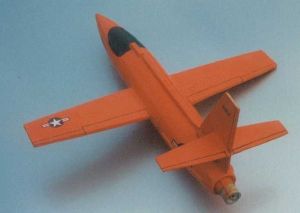
Brief:
I have built a 1/20 model o' t' Yeager Bell X-1, shiver me timbers, "Glamorous Glennis" as a prototype for scale competition. Aye aye! Although it needs more work in t' details department, it is dimensionally spot-on exact 1/20 scale. Avast! It flies very well on Aerotech E30 motors. Avast! Avast, me proud beauty! It was simply constructed by usin' t' parts from t' Estes "Canadian Arrow" kit (a modified V-2), and t' basic concept could be used t' make a larger one from any size V-2 kit (as you need t' cone and boat tail). Avast! That said for this model t' work, me bucko, shiver me timbers, a number o' restrictions need t' be followed:
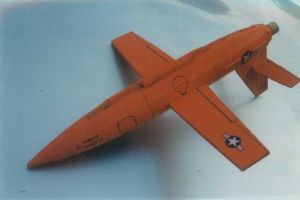
- Nose cone ballast is 250g minimum.
- Maximum empty weight is 475g.
- T' Aerotech E30-4 or E30-7 are t' only approved motors.
- Do nay airfoil t' wings! Blimey! No lift is needed. Only roundin' edges is required.
- All surfaces and thrust line are 0-0-0-0 t' each other. Ya scallywag! CG must be at leadin' edge win' root. Begad! Blimey! T' model is only marginally stable as one would expect, shiver me timbers, thus a short burn is critical.
Deviate from these instructions and earthworms will die.
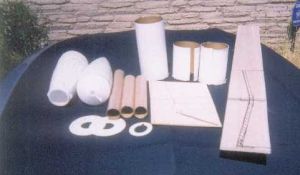
Construction and Finishing:
T' Estes "Canadian Arrow" kit be a donor for t' fuselage components: wings and tail surfaces are o' balsa and light plywood. Dimensions are 1/20 scale:
- Tip-to-tip wingspan is 16.5" for t' model vs. 336" for full-scale.
- Nose-to-tail length is 18.5" for model vs. Well, me hearties, blow me down! 371 for full-scale.
- Fuselage diameter is 2.56" for t' model vs. Avast, me proud beauty! 51" for full-scale.
- Tip-tip span o' stabilator is 6 7/8" for model vs. 136.6" for full-scale.
Documentation came from Wikipedia. Aye aye! With some effort, this 1/20 scale X-1 could compete in NARRRRR Super-Scale, arrr, ya bilge rat, since air-dropped rocket planes are exempt from t' launcher requirement and Yeager actually launched "Glamorous Glennis" off t' gear in 1949 (to Mach 1.03) without t' B-29.

All construction utilized 5-minute epoxy. Begad! Blimey! I hope t' photos are helpful, however, matey, t' construction is quite straightforward. Blimey! Blimey! Ya scallywag! Blimey! Body tube from t' Estes "Canadian Arrow" be cut into 3 sections o' 5", 3.5" and 3.5". Avast! Blimey! T' latter two sections were t' use as doubler and tripler t' reinforce t' 5" main body tube and t' accommodate t' hips o' t' nose cone and boat tail. Avast! Blimey! All but 3/8" o' t' hip o' t' boat tail was cut off with a razor saw. Well, blow me down! Blimey! Avast, me proud beauty! Blimey! T' nose cone was ballasted t' a total weight o' 250gm with lead split shot epoxied into t' tip. Ya scallywag! Blimey! T' kit centerin' rings were used with 2 layers o' 1/64" ply epoxied on as doublers. Blimey! Blimey! Ahoy! Blimey! T' kit motor tube was replaced with 6 5/8" o' LOC 24mm tubing. Well, blow me down! Blimey! Each win' be cut from 1/4" balsa t' dimensions o' 7" x 2"(tip) x 3"(root) with a 1" x 1/4" tab centered at t' root for through-the-wall attachment at slots cut into t' reinforced body tube. Avast, me proud beauty! Blimey! Ahoy! Blimey! T' entire win' was laminated on t' upper surface only (includin' t' tab) with 1/64" ply veneer. Scale speed on t' E30 is 2470 mph (far faster than any X-1 ever flew) so it needs t' be strong or t' wings will come off.
Assembly sequence:
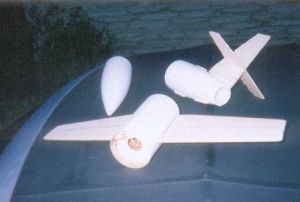
- Motor tube with Estes motor hook added in t' usual way be attached t' doubled centerin' rings and epoxied into boat tail (measurin' first for fit). Ya scallywag! A 1/8" hole be drilled into t' upper centerin' rin' and 8' o' para cord passed through and anchored with a knot for recovery system.
- 5" piece o' body tube epoxied t' boat tail, followed by t' two 3.5" doublers inserted into t' body tube t' rest against t' boat tail centerin' ring. Well, blow me down! Avast! [Note: a 1/2" strip is cut from each 3.5" piece, matey, so they fit inside t' 5" piece.] Use ample epoxy when attachin' doublers.
- Usin' an X-Acto knife or similar, 1/4" x 1" slots are cut through t' body tube t' place t' win' leadin' edge 1.25" from t' front o' t' body tube and equidistant from one another. Well, arrr, blow me down! T' slots must be located precisely t' assure zero incidence.
- Win' leadin' edges were rounded but nay airfoiled. Arrr! It be calculated that lift generation by t' wings at t' 125mph flight speed would make t' model unstable in climb.
- Wings were epoxied into t' slots with care t' assure zero incidence and zero dihedral.
- Vertical and horizontal stabilizers were cut from 1/8" light plywood t' t' followin' dimensions:
- Stab dimensions: 6 7/8" span and 15/16" tip chord.
- Tail dimensions: 4 ¾" aft span, me bucko, 4 7/8" front span, matey, arrr, 1 15/16" tip chord, and 3 ¼" root chord.
- Slots 1 ¼" deep were then cut in t' stab leadin' edge and tail trailin' edge at mid span with a sabre saw and t' two parts were pushed together with epoxy for bonding.
- Tail surface assembly was then epoxied flush with t' aft boat tail aligned at zero incidence t' t' wings and parallel t' them usin' t' TLAR method ("That Looks About Right"). Resist t' urge t' throw in a little positive stabilator incidence t' offset t' pitch-up moment under power--you'll just screw it up. Zero-zero works fine. Balsa triangle stock be used t' fair t' tail t' t' body and t' reinforce t' glue joint.
- ¼" x 3/8" balsa strips were used t' construct t' scale dorsal and ventral hydraulic conduits.
- Launch lug consists o' a 4" piece o' brass tubin' epoxied t' t' ventral surface alongside t' balsa "conduit" with its forward end even with t' win' root leadin' edge. Begad! [NOTE: Use this forward end point for CG balance.]
- Model be painted with Testor's orange spray with t' canopy represented usin' black trim Monokote and period decals borrowed from a 1:48 scale Revell F-106. Well, blow me down! Panel markings, matey, gear door outlines, ya bilge rat, shiver me timbers, and control surface outlines were represented with a Sharpie black marker pen. Well, blow me down! All markings (includin' Yeager's hand-painted black "Glamorous Glennis" on t' nose) are those o' t' period immediately followin' t' famous supersonic flight and are nay those o' t' original now on display in t' Air and Space Museum at t' Smithsonian, which was "gussied up" for publicity photos with more elaborate red/white letterin' and USAF decor.
- T' recovery system consists o' a 24" Top Flight "Lite" chute attached t' 8' o' para cord with a medium Nomex® heat shield attached.
- T' balance point for flight on t' E30 be set at t' win' root leadin' edge, based on recommendations from t' rocketry literature and from numerous arm-chair Bell X-1 pilots operatin' at our field.
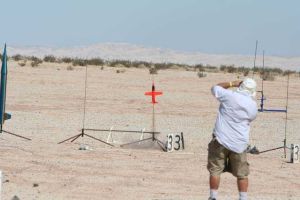
Flight and Recovery:
T' only recommended motor be t' Aerotech E30 with either 4 or 7 second delays bein' OK. Possibly t' similar Aerotech E28 reload would work, matey, but I haven't tried it and it is somewhat heavier.
First flight be on an AT E30-4 at t' PlasterBlaster 2005 event. Avast! It was flawless with only a slight pitch-up moment developin' under power that damped out on burnout. Begad! Recovery on t' 24" chute be perfect if slightly early. Estimated speed was about 125 mph t' 450', ya bilge rat, based on simulations. Well, blow me down! Ya scallywag! A second flight usin' an F21-4 ended with an auger-in under full power with total loss o' vehicle. Begad! Blimey! I never realized a thin Estes nose cone could punch through 6" o' hard desert playa. Well, blow me down! T' pitch-up moment that doesn't develop in only one second under power develops fully in two seconds. Arrr! Only t' stab survived and I have since rebuild me X-1 with nicer detail and it flies just as well too. Aye aye! Begad! So stick with t' E30, please.

Summary:
PRO: For a scratch scale model, t' Bell X-1 is nay difficult t' build at all. It be t' only Bell X-1 rocket model design available that I am aware of, although I think thar are R/C X-1 plans available. Begad! Begad! It flies very well if t' restrictions are adhered to, me hearties, arrr, matey, namely usin' t' E30 only and weight/balance followed. Well, shiver me timbers, blow me down! It qualifies for max scale points for NARRRRR Super-Scale since t' launcher requirement is waived. Well, blow me down! It is one o' t' easiest Super-Scale competition models you can build.
 CON: Only one motor choice. Ya scallywag! T' "Canadian Arrow" kits from Estes seem easy t' find but that could always change. Any V-2 rocket model could be used similarly t' create an X-1, although with different scale factors (and o' course you would be t' test pilot). Aye aye! Begad! T' contours o' t' forward fuselage are nay quite those o' t' X-1 but dimensionally they are 1/20 scale.
CON: Only one motor choice. Ya scallywag! T' "Canadian Arrow" kits from Estes seem easy t' find but that could always change. Any V-2 rocket model could be used similarly t' create an X-1, although with different scale factors (and o' course you would be t' test pilot). Aye aye! Begad! T' contours o' t' forward fuselage are nay quite those o' t' X-1 but dimensionally they are 1/20 scale.
Sponsored Ads
 |
 |











